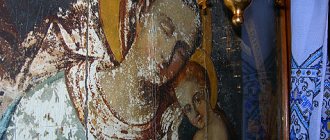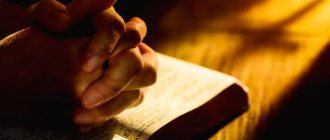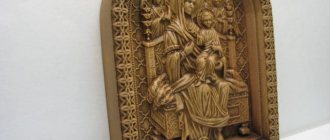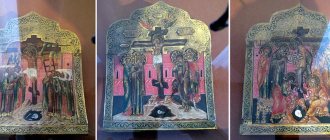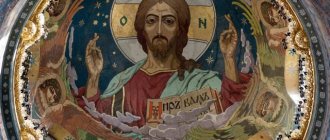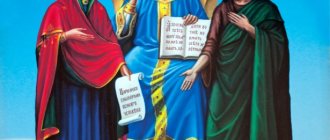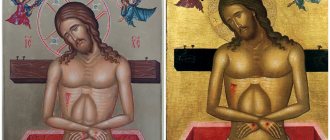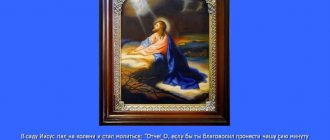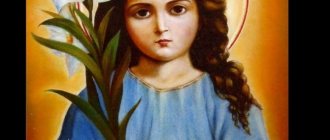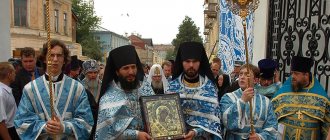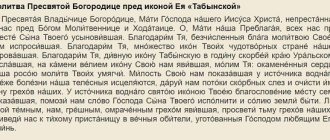Once upon a time, few people could learn to write. Few people had the chance to get an education. Therefore, images were actively used to spread religious ideas. Therefore, the icon depicting Jesus Christ on the crucifixion was called the Gospel or the Gospel for the illiterate.
The image combined all the necessary symbols of faith. So ordinary people could look at it, reflect, draw their own conclusions, and believers could discover something new, once hidden behind a veil of ignorance and misinterpretation of the meaning.
What to pray for
Life is always full of trials that the Lord sends in the hope of testing us and making us stronger. The icon “The Crucifixion of Christ” pursues one single goal - to strengthen the faith of the person praying and guide him on the true path.
The image of the crucified Christ is a symbol of the purification of the human race. The Lord, who took on human blood and flesh, lived his life as a man who took our sins with him. A prayer read near this icon cleanses the heart and clears the mind. If something bothers you, a feeling of anxiety weighs on your soul - pray to the “Crucifixion of Christ” icon and peace will return to your life.
Crucifixion
Albrecht Altdorfer. Crucifixion. Christ on the cross, Mary and John. 1515-1516.
Old Christian works, such as the Tale of the Tree of the Cross, now declared apocryphal, claim that the cross on which Christ was crucified was made from the tree of paradise, that is, from a tree that once grew in Paradise .
G. V. Nosovsky, A. T. Fomenko. King of the Slavs.
* * *
Albrecht Altdorfer. Crucifixion of Christ.
Andrea Mantegna. Crucifixion. 1457-1460.
Antonello da Messina. Crucifixion.
Antonello da Messina. Crucifixion.
Vasily Vasilievich Vereshchagin. Roman crucifixion. 1887.
Vasily Igorevich Nesterenko. Crucifixion. 1999.
Another very common inscription, present on the crucifixions of Christ and even mentioned in the Gospels, is this: “Jesus of Nazareth, King of the Jews.”
The Gospel of John says: “Pilate wrote an inscription and placed it on the cross. It was written: Jesus of Nazareth, King of the Jews... But the chief priests of the Jews said to Pilate: Do not write: King of the Jews... Pilate answered: What I have written, I have written” (John 19:19-22). The dispute between the high priests and Pilate is now quite understandable. After all, Andronicus - Christ had already been dethroned, so his opponents demanded that Pilate exclude the word “King”. Indeed, for a newly deposed king, the question of whether or not to write his royal title becomes moot. However, Pilate insisted on his own.
Thus, the Roman or Byzantine Empire of the 12th century, with its capital at Tsar-Grad on the Bosphorus, is called JUDA in the Gospels. This fits perfectly with our reconstruction, according to which Judea is Byzantium, subsequently Ottomania = Atamania, and then Turkey. And Israel is Rus'-Horde, and in a broader sense - the entire Great = “Mongolian” Empire, including Ottomania = Atamania. By the way, the Bible holds exactly this point of view: Judah is a small part of Israel that was separated from it during the division of the kingdom after King Solomon. However, it was in Judea that the old capital of the Empire, Jerusalem, was located. He, according to our research, is Troy, Tsar-Grad, Constantinople, Istanbul.
G. V. Nosovsky, A. T. Fomenko. "King of the Slavs."
* * *
Vasily Shulzhenko. Crucifixion.
Victor Mikhailovich Vasnetsov. Crucified Jesus Christ. Ceiling lamp of the main nave. Sketch of a painting for the Vladimir Cathedral in Kyiv.
Giovanni Bellini. Crucifixion.
Diego Velazquez. Crucifixion.
Ivan Glazunov. Crucify him.
Ilya Efimovich Repin. Golgotha (Crucifixion of Christ). 1869.
Jörg Brey the Elder. Agsbacher Altar. Crucifixion.
Luca Signorelli. Crucifixion.
Lucas Cranach the Elder. Crucifixion of Christ.
Master of the Aachen Altar. Aachen Altar. Crucifixion.
Master of the Novgorod school. Crucifixion.
Giotto's workshop. Crucifix with Our Lady, St. John the Evangelist and a pelican at the upper end of the cross.
Mathis Gotthart Grunewald. Inzenheim altar. Crucifixion.
Mathis Gotthart Grunewald. Tauberbischofsheim altar. Crucifixion.
Unknown artist. Crucifixion with the Mother of God, John the Evangelist and Mary Magdalene in attendance. 1465-1470.
Nicola Tournier. Crucifixion with Saint Vincent.
Paul Delvaux. Crucifixion. 1951-1952.
Pietro Perugino. Golitsyn triptych. Crucifixion with Mary and the Evangelist John.
Rembrandt Harmens van Rijn. Crucifixion. 1631.
Robert Campin. Crucifixion of Christ.
Rogier van der Weyden. Crucifixion.
Fra Angelico. Crucifixion with Mary and St. Dominic, Golgotha and the Skull of Adam.
Francisco de Zurbaran. Crucifixion.
Hans Memling. Altar triptych of the Lübeck Marienkirche. Crucifixion.
Hans Memling. Crucifixion.
Jusepe de Ribera. Crucifixion.
Charles Lebrun. Crucifixion.
El Greco. Crucifixion.
Jan Provost. Crucifixion. Beginning of the 16th century.
JESUS CHRIST
PAINTING. ALPHABETIC CATALOG.
SEE ALSO:
History of the icon
There is a common story in the Gospel. Everyone is familiar with it, even those who are far from Christianity. This is a story about the death and resurrection of the Savior.
Let us remember that those times were harsh. The criminals were judged to the fullest extent. And these are not empty words. If you think about it, the cross did not yet have the life-giving symbolism that it has today. Previously, this was a common device for executing especially terrible criminals. Jesus Christ, slandered by envious people, became a victim of a similar execution.
The crucifixion of Christ is a common subject. Not only icon painters, but also artists turned to him. “The Passion of Christ” can be traced in the works of Viktor Vasnetsov, Vasily Vereshchagin, El Greco, Francisco Go. And, nevertheless, painting is not capable of fully embodying the concept of the icon. The image should bring light, attract the lost to its side and give revelation to everyone.
Login to the site
Crucifixion and death of Jesus Christ. (Chapter from the “Law of God” by Archpriest Seraphim Slobodsky)
The execution of crucifixion was the most shameful, the most painful and the most cruel. In those days, only the most notorious villains were executed with such death: robbers, murderers, rebels and criminal slaves. The torment of a crucified man cannot be described.
In addition to unbearable pain in all parts of the body and suffering, the crucified man experienced terrible thirst and mortal spiritual anguish. Death was so slow that many suffered on crosses for several days. Even the perpetrators of the execution - usually cruel people - could not look at the suffering of the crucified with composure.
They prepared a drink with which they tried either to quench their unbearable thirst, or with the admixture of various substances to temporarily dull consciousness and alleviate torment.
Crucifix 15th century. Greece
Zmitrovich Gennady. Golgotha.
According to Jewish law, anyone hanged from a tree was considered cursed. The Jewish leaders wanted to disgrace Jesus Christ forever by condemning Him to such death.
Michelangelo Merisi da Caravaggio, Christ Carrying the Cros
When they brought Jesus Christ to Golgotha, the soldiers gave Him sour wine mixed with bitter substances to drink to ease his suffering. But the Lord, having tasted it, did not want to drink it. He did not want to use any remedy to relieve suffering. He took upon Himself this suffering voluntarily for the sins of people; That’s why I wanted to carry them through to the end.
Nesterov "Carrying the Cross"
When everything was prepared, the soldiers crucified Jesus Christ. It was around noon, in Hebrew at 6 o'clock in the afternoon. When they crucified Him, He prayed for His tormentors, saying: “Father! forgive them because they don’t know what they are doing.”
Nesterov Mikhail Vasilievich. Carrying the cross. (fragment)
Golgotha Komarov Nikolai.
Golgotha .Jan Brueghel the Younger
Next to Jesus Christ, two villains (thieves) were crucified, one on His right and the other on His left. This is how the prediction of the prophet Isaiah was fulfilled, who said: “and he was numbered among the evildoers” (Is. 53:12).
By order of Pilate, an inscription was nailed to the cross above the head of Jesus Christ, signifying His guilt. It was written in Hebrew, Greek and Roman: “Jesus of Nazareth, King of the Jews,” and many read it. The enemies of Christ did not like such an inscription. Therefore, the high priests came to Pilate and said: “Do not write: King of the Jews, but write what He said: I am the King of the Jews.”
But Pilate replied: “What I wrote, I wrote.”
Meanwhile, the soldiers who crucified Jesus Christ took His clothes and began to divide them among themselves.
They tore the outer clothing into four pieces, one piece for each warrior. The chiton (underwear) was not sewn, but entirely woven from top to bottom.
Then they said to each other: “We will not tear it apart, but we will cast lots for it, who will get it.” And having cast lots, the soldiers sat and guarded the place of execution. So, here too the ancient prophecy of King David came true: “They divided My garments among themselves, and cast lots for My clothing” (Psalm 21:19).
The enemies did not stop insulting Jesus Christ on the cross. As they passed, they cursed and, nodding their heads, said: “Eh! Destroying the temple and creating in three days! Save Yourself. If you are the Son of God, come down from the cross."
Also, the high priests, scribes, elders and Pharisees mocked and said: “He saved others, but he cannot save himself. If He is the Christ, the King of Israel, let him now come down from the cross so that we can see, and then we will believe in Him. Trusted in God; let God deliver Him now, if He pleases Him; for He said: I am the Son of God.”
Following their example, the pagan warriors who sat at the crosses and guarded the crucified, mockingly said: “If You are the King of the Jews, save Yourself.”
video “Today hanging on a tree” Choir of the Holy Trinity-Sergius Lavra
https://www.youtube.com/watch?v=CpzybgaaRYo
Even one of the crucified thieves, who was to the left of the Savior, slandered Him and said: “If You are the Christ, save Yourself and us.”
The other robber, on the contrary, calmed him down and said: “Or are you not afraid of God, when you yourself are condemned to the same thing (i.e., to the same torment and death)?
But we were condemned justly, because we accepted what was worthy of our deeds, and He did nothing bad.” Having said this, he turned to Jesus Christ with a prayer: “remember me (remember me), Lord, when You come in Your Kingdom!”
The merciful Savior accepted the heartfelt repentance of this sinner, who showed such wondrous faith in Him, and answered the prudent thief: “Truly I tell you, today you will be with Me in Paradise.”
At the cross of the Savior stood His Mother, the Apostle John, Mary Magdalene and several other women who revered Him. It is impossible to describe the grief of the Mother of God, who saw the unbearable torment of Her Son!
Jesus Christ, seeing His Mother and John standing here, whom he especially loved, says to His Mother: “Woman! Behold, Your son." Then he says to John: “Behold, your Mother.” From that time on, John took the Mother of God into his home and cared for Her until the end of Her life. Meanwhile, during the suffering of the Savior on Calvary, a great sign occurred.
From the hour the Savior was crucified, that is, from the sixth hour (and according to our account, from the twelfth hour of the day), the sun darkened and darkness fell throughout the entire earth, and continued until the death of the Savior.
This extraordinary, worldwide darkness was noted by pagan historical writers: the Roman astronomer Phlegon, Phallus and Junius Africanus. The famous philosopher from Athens, Dionysius the Areopagite, was at that time in Egypt, in the city of Heliopolis; observing the sudden darkness, he said: “either the Creator suffers, or the world is destroyed.”
Subsequently, Dionysius the Areopagite converted to Christianity and was the first bishop of Athens.
Nesterov "Crucifixion"
Around the ninth hour, Jesus Christ loudly exclaimed: “Either, Or! lima sabachthani! that is, “My God, my God! Why have you forsaken me?
These were the opening words from the 21st Psalm of King David, in which David clearly predicted the suffering of the Savior on the cross. With these words, the Lord reminded people for the last time that He is the true Christ, the Savior of the world.
Some of those standing on Calvary, hearing these words spoken by the Lord, said: “Behold, He is calling Elijah.” And others said, “Let us see if Elijah will come to save Him.”
The Lord Jesus Christ, knowing that everything had already been accomplished, said: “I thirst.”
Then one of the soldiers ran, took a sponge, wet it with vinegar, put it on a cane and brought it to the Savior’s withered lips.
Having tasted the vinegar, the Savior said: “It is finished,” that is, the promise of God has been fulfilled, the salvation of the human race has been completed.
Goya Francis. Crucifixion of Christ 1780
After this, He said in a loud voice: “Father! into Your hands I commend My spirit.” And, bowing his head, he gave up his spirit, that is, he died. And behold, the veil of the temple, which covered the holy of holies, was torn in two, from the top to the bottom, and the earth shook, and the stones were disintegrated; and the tombs were opened; and many bodies of the saints who had fallen asleep were resurrected, and coming out of their tombs after His resurrection, they entered Jerusalem and appeared to many.
The centurion (leader of the soldiers) and the soldiers with him, who were guarding the crucified Savior, seeing the earthquake and everything that was happening before them, were afraid and said: “Truly, this man was the Son of God.”
And the people, who were at the crucifixion and saw everything, began to disperse in fear, striking themselves in the chest.
Friday evening arrived. This evening it was necessary to eat Easter. The Jews did not want to leave the bodies of those crucified on the crosses until Saturday, because Easter Saturday was considered a great day.
Therefore, they asked Pilate for permission to break the legs of the crucified people, so that they would die sooner and they could be removed from the crosses. Pilate allowed. The soldiers came and broke the legs of the robbers.
When they approached Jesus Christ, they saw that He had already died, and therefore they did not break His legs. But one of the soldiers, so that there would be no doubt about His death, pierced His ribs with a spear, and blood and water flowed from the wound.
NOTE: See in the Gospel: Matthew, ch. 27, 33-56; from Mark, ch. 15, 22-41; from Luke, ch. 23, 33-49; from John, ch. 19, 18-37.
And more paintings and frescoes from my uploads
Valdivieso and Enarejos, Domingo "Descent from the Cross"
Borovikovsky. God the Father...
Vasnetsov. Entombment
Vasnetsov. (presumably) Entombment
Vrubel "Funeral lament"
Zhukovsky Pavel “Lamentation of Christ”
Nikolai Ge. “Return from the funeral”
Lamentation of Christ. Gaspar de Krayer 1584-1669
source
The plot and meaning of the icon of the crucifixion of Jesus Christ
Let's start with a description of the background.
It is made in darkened colors, which corresponds to one of the key plots of Christianity - people crucified God. According to evidence, at the moment of the crucifixion the light actually went dark. This moment is associated with a sign that the human race does not have such power over the Son of God. However, in some variations, you can see not a dark, but a golden background. This is due to the fact that the event, no matter how sad it is, is also joyful. Christ accomplished a redemptive feat for the entire human race; he cleansed everyone from original sin.
All figures depicted on the icon are canonical. Without them, the whole composition collapses. It is worth noting the central characters:
- The Mother of God next to the Son of God.
- John the Theologian. Disciple of Christ, one of the twelve apostles. Stands on the other side of the cross.
- Two crucified robbers. Tradition says that of the two criminals, only one believed in the Lord in the last moments of his life. He was the first person Jesus considered worthy of the Kingdom of God.
- Three Roman soldiers. Icon painters traditionally place them just below the cross on which the Savior was.
It was not for nothing that it was said that earlier, before writing became a common luxury for everyone, the transmission of religious ideas was carried out through icons and corresponding images. “The Crucifixion of Christ” can be called not just an icon, but a whole book, which contains the key point of the entire faith.
The Lord's plan was consistent with subsequent events. Christ had to die in order to be reborn and give everyone life after death in Paradise. The joy of this moment is indescribable.
LiveInternetLiveInternet
The execution of crucifixion was the most shameful, the most painful and the most cruel. In those days, only the most notorious villains were executed with such death: robbers, murderers, rebels and criminal slaves. The torment of a crucified man cannot be described.
In addition to unbearable pain in all parts of the body and suffering, the crucified man experienced terrible thirst and mortal spiritual anguish. Death was so slow that many suffered on crosses for several days. Even the perpetrators of the execution - usually cruel people - could not look at the suffering of the crucified with composure.
They prepared a drink with which they tried either to quench their unbearable thirst, or with the admixture of various substances to temporarily dull consciousness and alleviate torment.
Crucifix 15th century. Greece
Zmitrovich Gennady. Golgotha.
According to Jewish law, anyone hanged from a tree was considered cursed. The Jewish leaders wanted to disgrace Jesus Christ forever by condemning Him to such death.
Michelangelo Merisi da Caravaggio, Christ Carrying the Cross
When they brought Jesus Christ to Golgotha, the soldiers gave Him sour wine mixed with bitter substances to drink to ease his suffering. But the Lord, having tasted it, did not want to drink it. He did not want to use any remedy to relieve suffering. He took upon Himself this suffering voluntarily for the sins of people; That’s why I wanted to carry them through to the end.
Nesterov "Carrying the Cross"
When everything was prepared, the soldiers crucified Jesus Christ.
It was around noon, in Hebrew at 6 o'clock in the afternoon. When they crucified Him, He prayed for His tormentors, saying: “Father! forgive them because they don’t know what they are doing.”
Nesterov Mikhail Vasilievich. Carrying the cross. (fragment)
Golgotha Komarov Nikolai.
Golgotha .Jan Brueghel the Younger
Next to Jesus Christ, two villains (thieves) were crucified, one on His right and the other on His left. This is how the prediction of the prophet Isaiah was fulfilled, who said: “and he was numbered among the evildoers” (Is. 53:12).
By order of Pilate, an inscription was nailed to the cross above the head of Jesus Christ, signifying His guilt. It was written in Hebrew, Greek and Roman: “Jesus of Nazareth, King of the Jews,” and many read it. The enemies of Christ did not like such an inscription. Therefore, the high priests came to Pilate and said: “Do not write: King of the Jews, but write what He said: I am the King of the Jews.”
But Pilate replied: “What I wrote, I wrote.”
Meanwhile, the soldiers who crucified Jesus Christ took His clothes and began to divide them among themselves.
They tore the outer clothing into four pieces, one piece for each warrior. The chiton (underwear) was not sewn, but entirely woven from top to bottom.
Then they said to each other: “We will not tear it apart, but we will cast lots for it, who will get it.” And having cast lots, the soldiers sat and guarded the place of execution. So, here too the ancient prophecy of King David came true: “They divided My garments among themselves, and cast lots for My clothing” (Psalm 21:19).
The enemies did not stop insulting Jesus Christ on the cross. As they passed, they cursed and, nodding their heads, said: “Eh! Destroying the temple and creating in three days! Save Yourself. If you are the Son of God, come down from the cross."
Also, the high priests, scribes, elders and Pharisees mocked and said: “He saved others, but he cannot save himself. If He is the Christ, the King of Israel, let him now come down from the cross so that we can see, and then we will believe in Him. Trusted in God; let God deliver Him now, if He pleases Him; for He said: I am the Son of God.”
Following their example, the pagan warriors who sat at the crosses and guarded the crucified, mockingly said: “If You are the King of the Jews, save Yourself.”
video “Today hanging on a tree” Choir of the Holy Trinity-Sergius Lavra
https://www.youtube.com/watch?v=CpzybgaaRYo
Even one of the crucified thieves, who was to the left of the Savior, slandered Him and said: “If You are the Christ, save Yourself and us.”
The other robber, on the contrary, calmed him down and said: “Or are you not afraid of God, when you yourself are condemned to the same thing (i.e., to the same torment and death)?
But we were condemned justly, because we accepted what was worthy of our deeds, and He did nothing bad.” Having said this, he turned to Jesus Christ with a prayer: “remember me (remember me), Lord, when You come in Your Kingdom!”
The merciful Savior accepted the heartfelt repentance of this sinner, who showed such wondrous faith in Him, and answered the prudent thief: “Truly I tell you, today you will be with Me in Paradise.”
At the cross of the Savior stood His Mother, the Apostle John, Mary Magdalene and several other women who revered Him. It is impossible to describe the grief of the Mother of God, who saw the unbearable torment of Her Son!
Jesus Christ, seeing His Mother and John standing here, whom he especially loved, says to His Mother: “Woman! Behold, Your son." Then he says to John: “Behold, your Mother.” From that time on, John took the Mother of God into his home and cared for Her until the end of Her life. Meanwhile, during the suffering of the Savior on Calvary, a great sign occurred.
From the hour the Savior was crucified, that is, from the sixth hour (and according to our account, from the twelfth hour of the day), the sun darkened and darkness fell throughout the entire earth, and continued until the death of the Savior.
This extraordinary, worldwide darkness was noted by pagan historical writers: the Roman astronomer Phlegon, Phallus and Junius Africanus. The famous philosopher from Athens, Dionysius the Areopagite, was at that time in Egypt, in the city of Heliopolis; observing the sudden darkness, he said: “either the Creator suffers, or the world is destroyed.”
Subsequently, Dionysius the Areopagite converted to Christianity and was the first bishop of Athens.
Nesterov "Crucifixion"
Around the ninth hour, Jesus Christ loudly exclaimed: “Either, Or! lima sabachthani! that is, “My God, my God! Why have you forsaken me?
These were the opening words from the 21st Psalm of King David, in which David clearly predicted the suffering of the Savior on the cross. With these words, the Lord reminded people for the last time that He is the true Christ, the Savior of the world.
Some of those standing on Calvary, hearing these words spoken by the Lord, said: “Behold, He is calling Elijah.” And others said, “Let us see if Elijah will come to save Him.”
The Lord Jesus Christ, knowing that everything had already been accomplished, said: “I thirst.”
Then one of the soldiers ran, took a sponge, wet it with vinegar, put it on a cane and brought it to the Savior’s withered lips.
Having tasted the vinegar, the Savior said: “It is finished,” that is, the promise of God has been fulfilled, the salvation of the human race has been completed.
Goya Francis. Crucifixion of Christ 1780
After this, He said in a loud voice: “Father! into Your hands I commend My spirit.” And, bowing his head, he gave up his spirit, that is, he died. And behold, the veil of the temple, which covered the holy of holies, was torn in two, from the top to the bottom, and the earth shook, and the stones were disintegrated; and the tombs were opened; and many bodies of the saints who had fallen asleep were resurrected, and coming out of their tombs after His resurrection, they entered Jerusalem and appeared to many.
The centurion (leader of the soldiers) and the soldiers with him, who were guarding the crucified Savior, seeing the earthquake and everything that was happening before them, were afraid and said: “Truly, this man was the Son of God.”
And the people, who were at the crucifixion and saw everything, began to disperse in fear, striking themselves in the chest.
Friday evening arrived. This evening it was necessary to eat Easter. The Jews did not want to leave the bodies of those crucified on the crosses until Saturday, because Easter Saturday was considered a great day.
Therefore, they asked Pilate for permission to break the legs of the crucified people, so that they would die sooner and they could be removed from the crosses. Pilate allowed. The soldiers came and broke the legs of the robbers.
When they approached Jesus Christ, they saw that He had already died, and therefore they did not break His legs. But one of the soldiers, so that there would be no doubt about His death, pierced His ribs with a spear, and blood and water flowed from the wound.
NOTE: See in the Gospel: Matthew, ch. 27, 33-56; from Mark, ch. 15, 22-41; from Luke, ch. 23, 33-49; from John, ch. 19, 18-37.
source https://days.pravoslavie.ru/Life/life1196.htm
And more paintings and frescoes from my uploads
Valdivieso and Enarejos, Domingo "Descent from the Cross"
Borovikovsky. God the Father...
Vasnetsov. Entombment
Vasnetsov. (presumably) Entombment
Vrubel "Funeral lament"
Zhukovsky Pavel “Lamentation of Christ”
Nikolai Ge. “Return from the funeral”
Lamentation of Christ. Gaspar de Krayer 1584-1669
Contents of the icon
In the 9th-10th centuries, icons were executed in such a way as to give people food for thought.
Darkening of the background and highlighting important details were deliberately used. The image had to be clear, as if real. The goal of the icon painters was to provide the believer with the effect of presence. Through the dark background, but the radiant image of Christ, an attempt was made to highlight the Son of God from the icon. And in most of the works the goal was achieved. In icons of this kind, the gold color plays a huge role. It is not for nothing that icon painters give it a special place in their works. According to the canon, it is believed that gold is a symbol of God’s Kingdom, a symbol of power. Therefore, Christ, depicted as a martyr, is not one. And with his power he is immortal.
Angels are often depicted at the top. Some icons contain such an element as cracked earth. This element is associated with another biblical event, when at the time of the crucifixion of Christ, an earthquake occurred.
Description of the icon
Depending on which school of icon painting the icon belongs to, key points may differ. For example, the same plot of the crucifixion of the Son of God can be reflected differently in Orthodox and Catholic masterpieces.
INTERESTING: Icons of the Lord God.
In Catholic tradition, Jesus has his legs crossed, pierced with a single nail. In Orthodoxy it is completely different. There Christ was crucified with four nails. The palms, according to Orthodox tradition, must be open.
Prayers before the icon
An Orthodox person must understand that icons have miraculous power if read with faith, love and hope. This ennobles the believer’s soul, and he certainly receives the support of higher powers.
You can read the prayer to the holy image “The Crucifixion of Christ” both in church and at home. When reading is carried out in the temple, a person must open his heart and not hide anything from the Almighty, because he sees everything. Such reading, according to parishioners, has the miraculous power of bringing the soul closer to God.
But there are situations when it is not possible to visit church. Time, things don't let up. In this case, the prayer can be read privately (at home). To do this, you need to purchase candles and have the image of the “Crucifixion of Christ” on hand. Even a small image will help you in a difficult situation. Candles create the necessary mood. Share with the Almighty everything that worries you. Ask him for protection, support, be honest with him.
WE RECOMMEND: Prayer of thanksgiving to the Lord.
Prayers can help with this:
